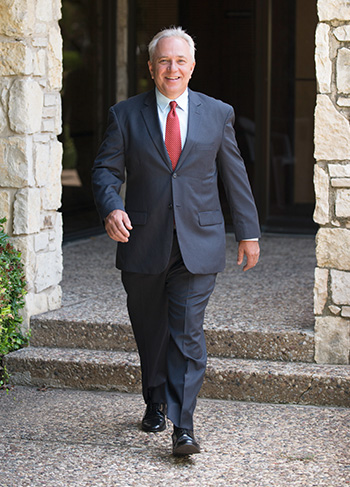Preparing for retirement: the longest vacation
Preparing for retirement: the longest vacation

David J. Quick, CPA • Dallas, TX
Hearthstone Financial, Inc. • Foresters Equity Services, Inc.
As changes in the interest rate environment have undermined retirement’s traditional safe havens, David Quick has turned to active management platforms to manage client risk and generate returns in the years to come.
Proactive Advisor Magazine: Tell me about your background, David?
I am a graduate of the University of Missouri-St. Louis, where I majored in business administration and economics. I began my career working as a CPA, and worked for two of the large national accounting firms. I also have been involved at a senior level with several financial services organizations and worked in corporate finance, investment banking, and real estate. I decided to branch out on my own in the early 1990s, originally focusing on tax and accounting services. I have since grown that into a full-service financial planning and advisory practice.
I primarily work with people who are retired or about to retire, and I think my CPA background has brought a number of advantages to my clients that many advisors may not necessarily have. The tax consequences of how a client invests and generally manages his or her finances is a very strong consideration in my work. I also always put my CPA hat on as I do my own due diligence on specific investments or evaluate the strategies of third-party active money managers.
“Volatility is often held up as a measure of risk … but risk to me really means my clients are losing money.”
How has your investing philosophy evolved to bring you to use actively managed accounts?
When I first began on the advisory side, modern portfolio theory was certainly popular and something that I’d spent considerable time taking a look at. I had the belief, as did many, that it was possible to diversify away from risk by constructing a portfolio that was mathematically calculated to put the client’s portfolio along the efficient frontier.
In the late 1990s and early 2000s, I became very concerned with market valuations, the whole dot-com bubble, how fundamental analysis seemed to be out of favor, and how traditional correlations, or lack of correlations, were no longer working as they should. I moved a lot of client money into indexed annuities with guaranteed minimums, which worked well for that time period. I essentially built my practice around products that allowed clients a risk-free income stream and the promise of some upside participation, if the market cooperated.
Over time that method of managing client risk has become far less attractive with the changes in the interest rate environment. While there are some exceptions, annuities just do not generate enough interest income to structure those products, or hedge risk, as they have in the past. And the interest rate environment affects all investments and asset classes. It has made it very difficult for individuals who are at or near retirement to seek traditional safe havens. This has posed tremendous amounts of risk for the average retirement investor who wants to generate income relatively safely and continue to build their asset base over the long term.
How do you attempt to deal with risk for clients?
This is where third-party managers and active money management comes into play. I was systematically searching for answers for my clients when these guaranteed returns became unattractive. Financial advisors are trained to try to measure risk in terms of volatility, the standard deviation from the mean return. That volatility measurement is often held up as a measure of risk, but I will tell you in plain English, risk to me really means my clients are losing money.
I began looking for ways where I could effectively manage my clients’ portfolios with a strategy in place designed to prevent large losses. This is something that my clients somehow inherently thought that mutual fund managers should be doing for them all along, but mutual funds really cannot and do not, due to their style mandates. We saw the results of that in 2008-09.
So I was looking for a more rules-based, non-emotional investment approach that attempted to prevent large losses. I wanted an approach that was designed on mathematical principles and model-based algorithms, with more or less constant market analysis, and the guiding philosophy that the trends and cycles of market history tend to repeat themselves. If and when we have another market crash, I want to make sure my clients have a line of defense in place.
That is what active management, at least as practiced by the strategies I am using, is designed to do. Some strategies also have another tactical feature that is very compelling—the ability to not only go to cash in a down market, but to trade inversely to the market to make a profit during unfavorable market conditions.
I think the alternative to active money management—those modern portfolio/efficient frontier approaches that rebalance quarterly—delivered losses close to 30% in 2007-09. I do not have any client for whom I consider that an acceptable level of loss. And the math will tell you how hard it is to recover from such losses, especially if you are drawing income against your investment portfolio in retirement.
Active management platforms provide a place for me to find strategies for my clients that will help them achieve the objective of preventing those large losses and generating returns whether markets are up or down. There are, of course, no guarantees, but that is the concept, and I have conducted very thorough research and due diligence, along with my broker-dealer.
These are some pretty sophisticated concepts. How do you communicate them to clients?
 Clients understand the concept of wanting to avoid large losses in their portfolios. I have a variety of ways I describe it and tools I use showing the history of the markets and the expectation that the next major market correction has a high probability of arriving in due course. I also explain that the theory of what we are trying to achieve is not to beat the market, or to match the highest returns of the strongest-performing market years. We are trying to smooth out returns, keep things on the positive side of the ledger, and avoid the large losses of very bad market years. And, if we go into an identifiable bear market, we have ways to make money then also. That inherently makes sense to people.
Clients understand the concept of wanting to avoid large losses in their portfolios. I have a variety of ways I describe it and tools I use showing the history of the markets and the expectation that the next major market correction has a high probability of arriving in due course. I also explain that the theory of what we are trying to achieve is not to beat the market, or to match the highest returns of the strongest-performing market years. We are trying to smooth out returns, keep things on the positive side of the ledger, and avoid the large losses of very bad market years. And, if we go into an identifiable bear market, we have ways to make money then also. That inherently makes sense to people.
One simple analogy I use relates specifically to their journey of retirement. I describe this as the longest vacation they will ever take and the need for the appropriate vehicles to carry them through that vacation. No one would consider taking a trip cross country in a car that had only one gear—the forward gear, constantly pressed to the floor. There are times you need a car to slow down, to stop, and to be put into reverse, depending on your destination, your progress toward your goal, and the driving conditions.
Same thing with an investment strategy in terms of needing all of the options available to make the required adjustments along the road. I believe this approach will make for a more comfortable and productive journey for my clients over the long haul.
Disclosure: David J. Quick, CPA, is an investment advisor representative offering securities and advisory services through Foresters Equity Services, Inc., member FINRA, SIPC and a registered investment advisor. Hearthstone is independent of Foresters Equity Services, Inc. Hearthstone Financial, Inc., is not a CPA firm.
Photography by Robert Hart


